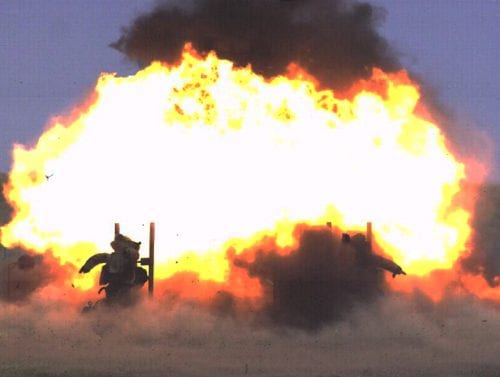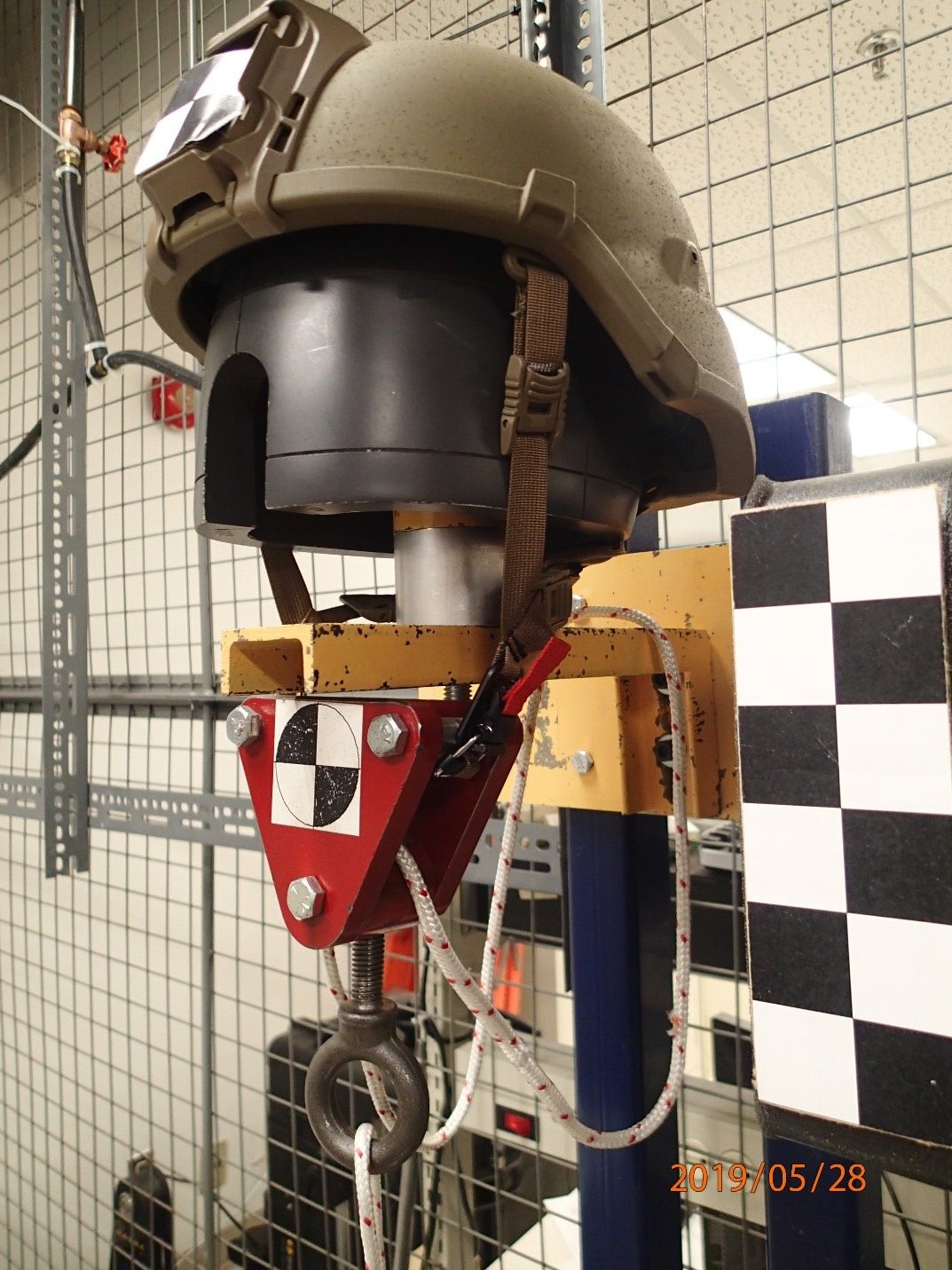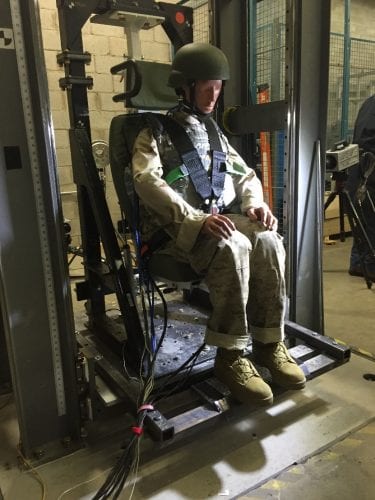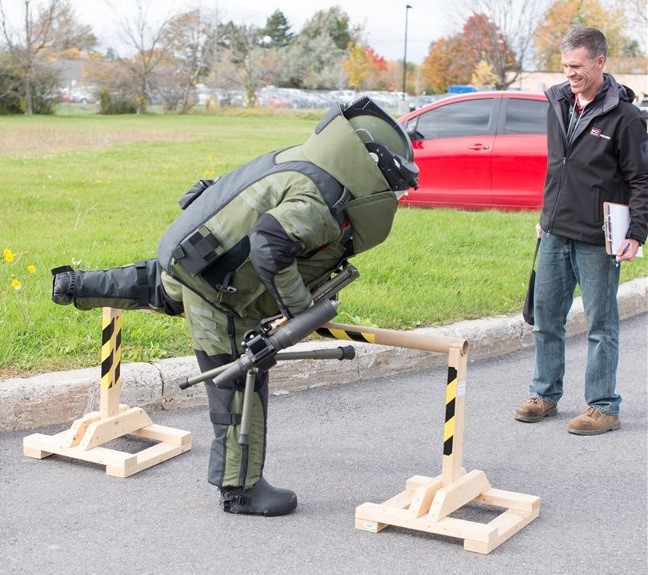Rapid Development
Research and Development (R&D) is a core function of Med-Eng and plays a central role in the rapid development and validation of new products and underlying research for all of its protective equipment including Med-Eng Bomb Disposal suits, Blast Attenuation Seats, Blast Sensors and Thermal Management Systems.
Here is a summary of the R&D team’s mandate, expertise and the many forms of testing conducted to validate equipment:
Mandate
- Identify and develop innovative technologies
- Determine material requirements
- Develop and execute test protocols for equipment evaluation
- Develop, in collaboration with other research organizations and industries, performance standards for personal protective equipment, blast dosimetry sensors, and blast mitigation technologies
- Ensure all products developed by Med-Eng meet or exceed performance expectations
Expertise
The backbone of our R&D team is extensive scientific knowledge applied by our scientists and engineers at the doctorate level in disciplines including:
- Blast and shock wave physics
- Ballistic materials and science
- Blast sensors and electronics
- Numerical simulations (Finite Element Models) for blast and impact
- Biomechanics of impact
- Human thermal physiology
- Human factors and ergonomics
Testing
The R&D team’s research engineers and scientists carry out comprehensive equipment evaluation and fundamental research, including:
Full-scale Blast Testing

This involves blast tests with instrumented anthropomorphic mannequins, equipped with blast protective equipment, facing high explosives, anti-personnel mines, improvised explosive devices (e.g., pipebombs), Vehicle Borne IEDs (VBIEDs) and grenades. Blast testing is conducted at external laboratories, such as the Canadian Explosives Research Laboratory (Ottawa) for blast chamber testing, CFB Petawawa, DRDC Valcartier and DRDC Suffield for large scale blast testing.
Extensive blast testing on Med-Eng Bomb Suits and other blast protective equipment quantifies and qualifies its life-saving capabilities. In the test illustrated in this photograph, two instrumented Hybrid III anthropomorphic test mannequins, commonly referred to as crash-test dummies, were dressed in full EOD suits and subjected to standardized explosive tests. This test protocol, devised by Med-Eng, represents a typical threat seen by EOD operators.
To quantify the EOD Ensembles protection results, each mannequin is instrumented with pressure transducers at their ears and chest, and a tri-axial cluster of accelerometers within the head. The protected pressure results are then compared with a reference pressure gauge.
Extensive blast testing on Med-Eng Bomb Suits and other blast protective equipment quantifies and qualifies its life-saving capabilities. In the test illustrated in this photograph, two instrumented Hybrid III anthropomorphic test mannequins, commonly referred to as crash-test dummies, were dressed in full EOD suits and subjected to standardized explosive tests. This test protocol, devised by Med-Eng, represents a typical threat seen by EOD operators.
To quantify the EOD Ensembles protection results, each mannequin is instrumented with pressure transducers at their ears and chest, and a tri-axial cluster of accelerometers within the head. The protected pressure results are then compared with a reference pressure gauge.
Ballistic Testing
This testing, usually referred to as “V50” testing, is carried out to determine the efficacy of various materials and material combinations to stop fragmentation (based on known military standards). Med-Eng is a pioneer in the EOD and demining arenas in performing V50 testing against a range of fragment simulating projectiles (2, 4, 16, 64 grain Right Circular Cylinders; 17, 44 and 207- grain chisel shaped). Med-Eng houses its own state-of-the-art ballistic range to conduct such tests and conduct tests at external test laboratories to generate independent third-party test data.
Impact Testing

Med-Eng’s blunt impact laboratory houses a drop-tower apparatus to perform impact tests of helmets and other protective materials, as well as sensor impact validation. The laboratory also includes other specialized test equipment, such as a retention system test rig, validating that helmets are capable of resisting severe impacts and pulls, typical of what is experienced during blast exposure. Med-Eng conducts blunt impact testing and retention system tests according to recognized standards, such as the NIJ 0117.01 standard for Public Safety Bomb Suits. Med-Eng also owns high-speed cameras to appropriately document and characterize impact events, as well as instrumented Hybrid III anthropomorphic mannequins to assess the protection capability of its equipment in realistic configurations.
The helmet retention system test ensures that its helmets are capable of resisting severe impacts and pulls, typical of what is experienced during blast exposure. Med-Eng conducts retention system tests according to recognized standards, such as the NIJ 0117.01 standard for Public Safety Bomb Suits. The retention system test consists of applying a large load to the system, either statically (NIJ method) or dynamically (other test standards).
The helmet retention system test ensures that its helmets are capable of resisting severe impacts and pulls, typical of what is experienced during blast exposure. Med-Eng conducts retention system tests according to recognized standards, such as the NIJ 0117.01 standard for Public Safety Bomb Suits. The retention system test consists of applying a large load to the system, either statically (NIJ method) or dynamically (other test standards).
Blast Mitigation Seat Testing

Med-Eng is at the forefront of test methodologies development for blast mitigation seat testing and validation. The seat drop tower is equipped with high-speed cameras and advanced data acquisition capabilities. Instrumented Hybrid III anthropomorphic mannequins are used to characterize the loading upon impact. Drop tests generate impacts that are representative of a military vehicle subjected to under-belly blast exposure, with the drop parameters (drop height, impact velocity) being determined based on vehicle field data. This in-house test facility allows Med-Eng blast mitigation seat designers to quickly test and improve their concepts.
Ergonomic/Biomechanical/Human Factors Testing

Med-Eng carries out anthropometric and ergonomic assessments of its personal protective equipment, either internally with its expert Human Factors engineers, or in conjunction with academic, governmental, and industry partners. This ensures that it meets the stringent requirements of standards and customer requirements.
For example, Med-Eng bomb suits are designed to maximize flexibility and comfort, to help bomb technicians perform their duties. To verify these, Med-Eng performs “Human Factors” trials, consisting of various realistic exercises aimed at testing the ability of volunteers (former bomb technicians among the Med-Eng staff) to conduct various tasks. In addition to meeting the minimum ergonomic and human factors requirements from the NIJ 0117.01 standard for Public Safety Bomb Suits, the equipment is tested in a wide array of configurations and realistic environments (including the use of standard EOD tools), to ensure an optimal experience to all users.
For example, Med-Eng bomb suits are designed to maximize flexibility and comfort, to help bomb technicians perform their duties. To verify these, Med-Eng performs “Human Factors” trials, consisting of various realistic exercises aimed at testing the ability of volunteers (former bomb technicians among the Med-Eng staff) to conduct various tasks. In addition to meeting the minimum ergonomic and human factors requirements from the NIJ 0117.01 standard for Public Safety Bomb Suits, the equipment is tested in a wide array of configurations and realistic environments (including the use of standard EOD tools), to ensure an optimal experience to all users.
Collaborative Relationships
Med-Eng’s R&D Department actively works with many partners from academia, governmental and military institutions, and industry.
Standards Associations▼
Universities▼
- University of Waterloo, Mechanical Engineering
- University of Ottawa, Mechanical Engineering and School of Human Kinetics
- McGill University, Montreal, Shock Wave Physics Group, Mechanical Engineering
- University of Virginia, Automotive Safety Laboratory
- University of South Florida
- Kansas State University – Institute for Environmental Research
United States Government Organizations▼
Canadian Government Organizations▼
- Royal Canadian Mounted Police (RCMP)
- Canadian Police Research Centre (CPRC)
- Natural Resources Canada, Canadian Explosives Research Laboratory (CERL)
- Canadian Department of National Defence (DND)
- Defence Research and Development Canada – Suffield (DRDC Suffield)
- Defence Research and Development Canada – Valcartier (DRDC Valcartier)
- Canadian Centre for Mine Action Technologies (CCMAT)
- Defence Research and Development Canada – Toronto (DRDC-Toronto)
- CBRN Research and Technology Initiative – CRTI
- Environment Canada – Emergencies Science and Technology Section
- Canadian Food Inspection Agency (CFIA)
- National Research Council (NRC), Emerging Technologies Division
- Industrial Research Assistance Program (IRAP)
- Materials and Manufacturing Ontario (MMO)
- Royal Military College of Canada (RMC – Kingston)
- Canadian Safety and Security Program (CSSP)
International Organizations▼
Published Papers & Speaking Engagements
The R&D team publishes scientific and industrial papers based on its extensive research efforts carried out. These papers are put forth to share the results of research with associated industrial, governmental, military, and academic collaborators, so as to further advance the state of the art in personal protective systems and other protection technologies.
